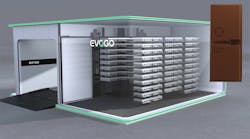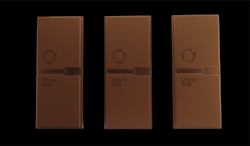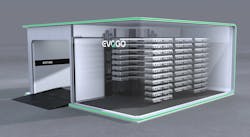Battery-Swapping Stations Pick Up the Pace in China
What you'll learn:
- The technology behind CATL's Choco-ESB swapping electric block.
- The EVOGO battery-swapping ecosystem developed by CATL.
- Details of NIO's battery-swapping station network in China.
Battery supplier CATL, the world’s largest EV battery maker, revealed that it’s entering the field of electric-vehicle (EV) battery-swap stations. The company claims its module, using a modular format, can be switched out of a car automatically in just one minute.
Seeking to compete with dc fast-charging systems, CATL says the module is compatible with 80% of "global BEV platform-based vehicle models" currently available, as well as all battery-electric platform-based vehicles that will debut in the next three years
Designed to look like a bar of chocolate, the “Choco-SEB (swapping electric block)” implements CATL’s cell-to-pack technology, in which the cells are integrated directly into the battery pack (or in this case, the block). It’s a mass-produced battery specially developed for EV battery-sharing that’s claimed to have the advantages of high-energy density with small size and minimalist design.
Says CATL, "With the support of the latest CTP (cell-to-pack) technology, it can achieve a weight energy density of over 160 Wh/kg and a volume energy density of 325 Wh/L, enabling a single block to provide a driving range of 200 km.”
Operated by CATL subsidiary Contemporary Amperex Energy Service Technology Ltd. (CAES), the company plans to launch battery-swap stations in 10 cities in China as a start, offering the first real competition to NIO's battery-swap concept.
What is EVOGO?
The battery-swap solution, named EVOGO, is comprised of battery blocks, fast battery-swap stations, and an app. The EVOGO station itself has the footprint of three regular parking spots, can house up to 48 Choco-SEBs, and enables one-minute swapping for a single battery block, ensuring fully charged batteries for customers without a long wait. In comparison, Tesla’s fast-charging technology dubbed Supercharger usually takes 15 minutes to recharge up to 200 miles of range.
To solve the problems of range anxiety, the inconvenience of refueling, and high total cost of EV ownership, most car owners tend to purchase EVs of higher power capacity than they require—only 10% to 20% of the total capacity is usually needed for daily use. Thus, they pay a high cost for a power capacity rarely needed.
Helping Overcome Range Anxiety
To address the pain point, EVOGO allows customers to choose the number of battery blocks to rent according to their driving scenarios and habits. Customers are free to take one to three blocks to meet different range requirements at swap stations. Only one block may be needed for inner city commuting, while for longer trips, customers can rent two to three blocks and swap them with one block after returning to the city.
What’s more, being equipped with wireless BMS technology, the Choco-SEB doesn’t have any parts on its exterior except the high-voltage positive and negative terminals. This significantly increases the reliability of plugs.
The app links customers with different modules of EVOGO, allowing the connection among customers, vehicles, stations, and batteries. It will tie customers with the swapping service to line up a battery block when en route. Via the app, the customer can choose whether they only need one block for commuting or two or three blocks for a longer distance drive.
Unlike other battery-swap solutions, EVOGO has two modes of compatibility. Choco-SEB is designed to suit vehicles ranging from Class-A00, Class-B, and Class-C passenger cars to logistics vehicles. At the same time, the swap stations can match all vehicle models with different OEMs that use Choco-SEBs, enabling a free choice of vehicle models for battery swaps.
Charge or Swap
Vehicles carrying Choco-SEBs support both charging and battery swapping for refueling. Together with the existing household charging and fast charging, EVOGO helps provide an all-scenario power refueling solution.
Batteries are the most expensive component of an electric vehicle, and battery swapping is seen as a way of lowering the price of EVs, as the cars are sold without the battery. Instead, EV owners pay a subscription for the battery, thus ushering in the “battery-as-a-service” concept.
EVOGO stations will allow users of compatible EV models to swap out depleted battery blocks for freshly charged ones. The Choco-SEB blocks will still be able to be recharged at home or at a charging station, so the swapping feature doesn’t reduce the number or type of recharging options.
The establishment of CAES helps CATL complete the closed loop of the battery lifecycle that ranges from development, manufacturing, and using to recycling. The first car compatible with CATL’s EVOGO service is the Bestune Nat MPV built by FAW Group, a pure electric model specially built for ride-sharing. CAES promises that more vehicle models compatible with EVOGO’s service will be launched in the future.
A high level of compatibility with modern EVs is a selling point, making battery swapping a part of an ecosystem that already exists for electric scooters in Asia, where the battery-as-a-service business model already exists.
NIO’s Swapping Network
CATL is the second big company in China to build battery-swapping stations, with EV maker NIO already having a network of 700 such stations in place. Last year, NIO took the wraps off its second-generation Power Swap Station 2.0. It’s the first to permit vehicles to maneuver automatically into the station, rather than have the driver lead the car in manually, so that users can experience a battery swap while staying inside the vehicle.
NIO’s proprietary solution offers a full long-range battery swap in about five minutes. Each NIO Power Swap Station 2.0 has 239 sensors and four cloud-computing systems that employ visual-recognition technologies, according to the automaker.
So far, NIO has provided over 5.3 million swaps to users in China. Automatic battery and electric system checks are performed during each swap to keep both the vehicle and battery in shape. In December, NIO installed its 700th battery-swap station in China, hitting its annual target ahead of schedule.
At the end of November, 42.34% of NIO users lived within three kilometers from their nearest battery-swapping station. The "Station to Vehicle" ratio has dropped to 258, meaning on average each battery-swap station serves 258 cars.
In the coming years, NIO aims to establish a network spanning Europe and is scouring Norway, Denmark, Sweden, Germany, and the Netherlands for suitable locations. The company has already begun to build stations in Norway, and by the end of 2022 it will have established 20 Power Swap stations.
What locations are suitable? NIO says the following spaces are desirable to them:
- Highway intersections
- Motorways
- Charging stations
- Gas stations
- Shopping centers
NIO has plans to reach a total of 1,300 battery-swap stations by the end of the year and 4,000 stations globally by 2025. NIO’s battery-swap station building spree has even eclipsed its supercharging station building efforts, with NIO opening a total of 637 supercharging stations and 645 stations offering slower charging. The system can complete up to 312 battery swaps per day, significantly improving swapping efficiency.
NIO has offered this “battery-as-a-service” option in China for a couple of years. The company’s service also reduced the price of each electric vehicle by $10,000 because the battery service is decoupled from the sale of the car.
In the U.S., Bay Area startup Ample claims to have a modular solution that can be used on a wide range of vehicles. It’s working with Uber to demonstrate the tech on a fleet of Nissan Leafs and Kia Niro EVs, and has partnered with Uber to offer battery-swapping services to Uber drivers in California.
The launch of CATL’s battery-swapping service comes as EV sales have taken off in China and companies are competing to cut costs and reduce range anxiety. Last September, carmaker Geely announced plans to set up 5,000 battery-swapping stations for EVs globally by 2025. Last year, too, battery swapping startup Ample launched the first five stations in this country, all in the San Francisco area.


